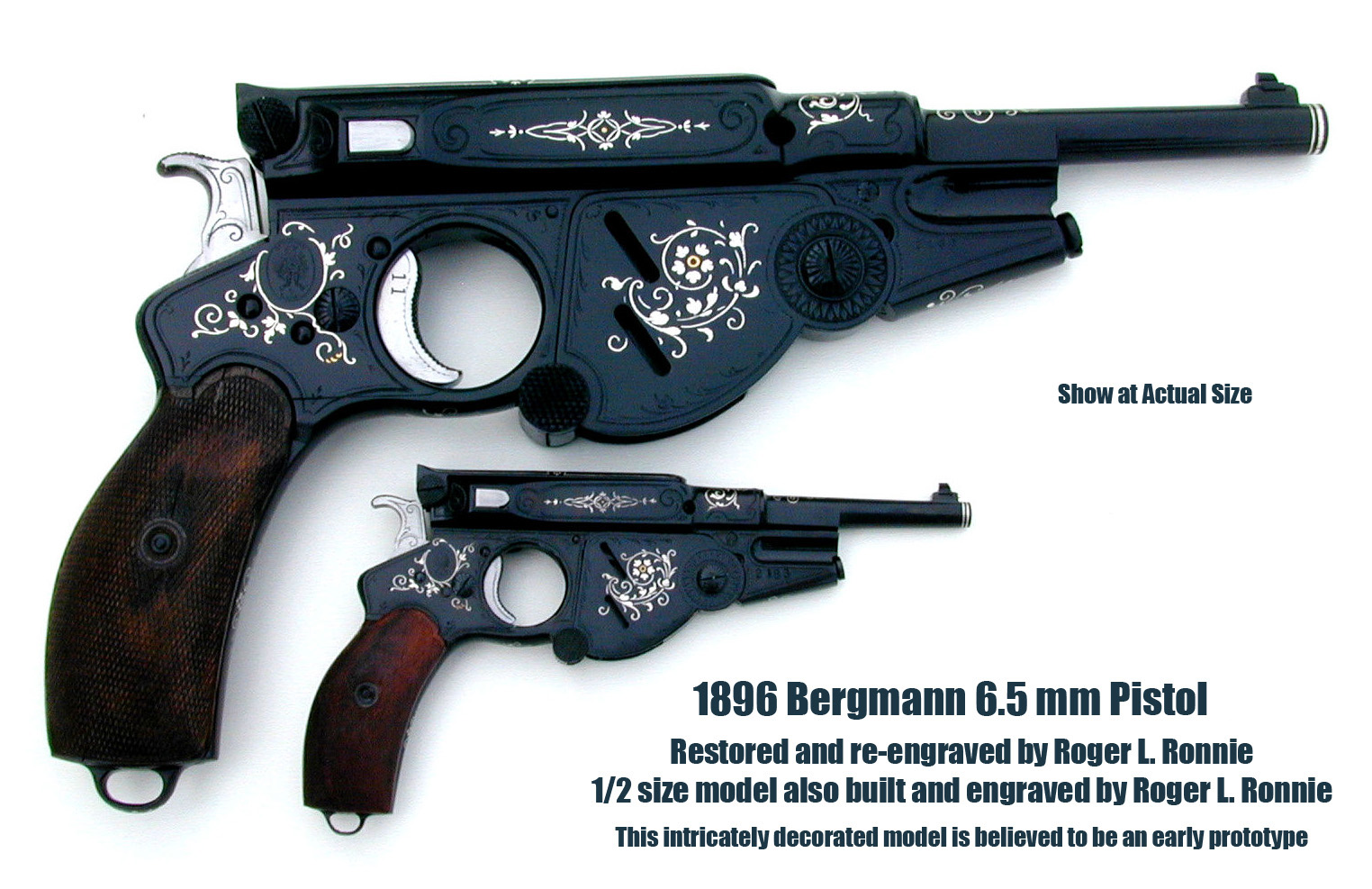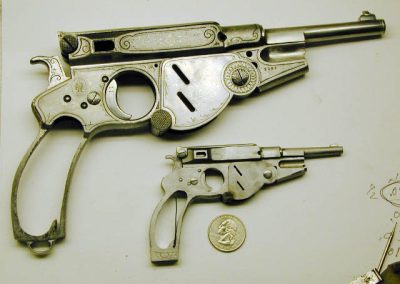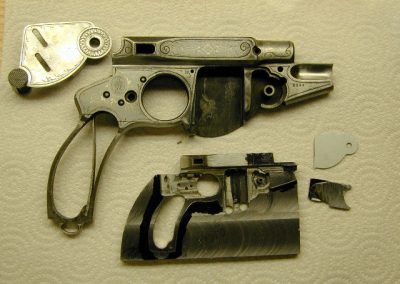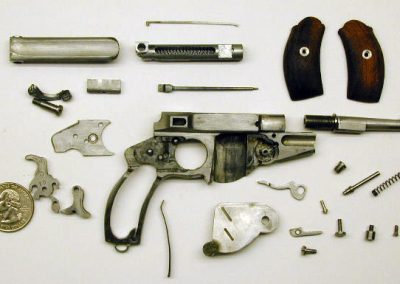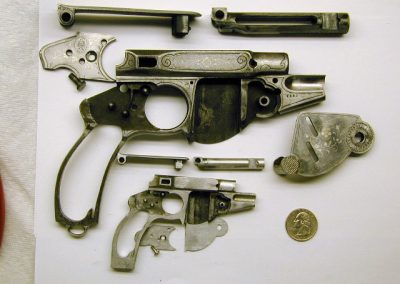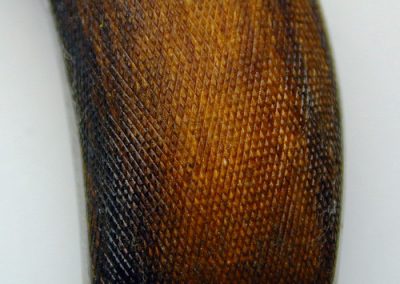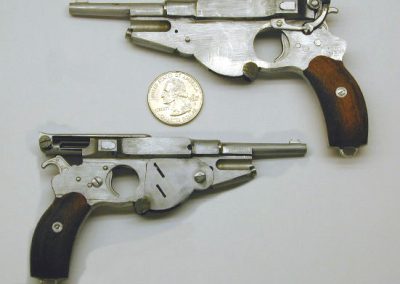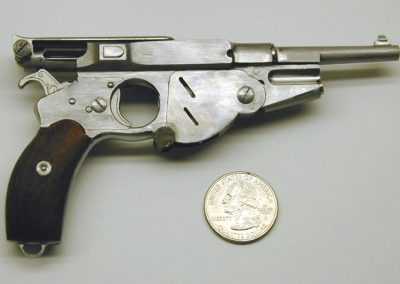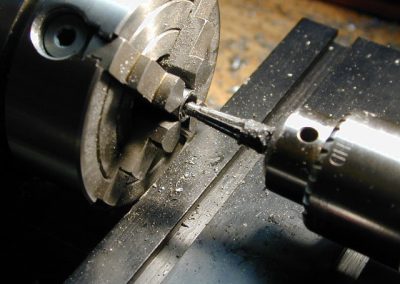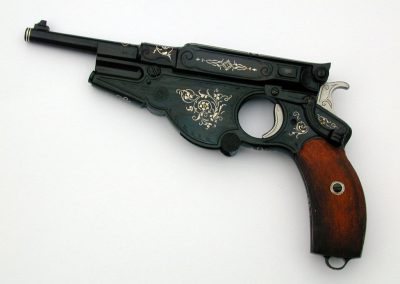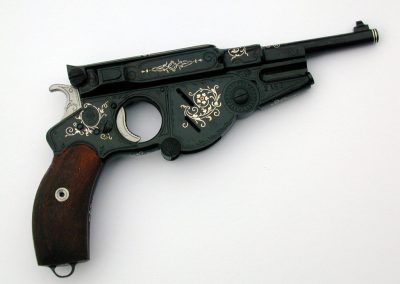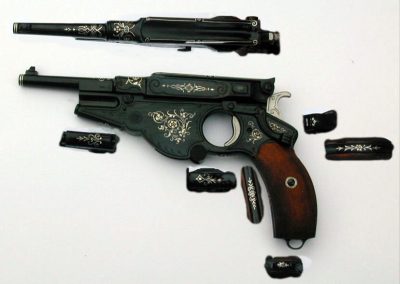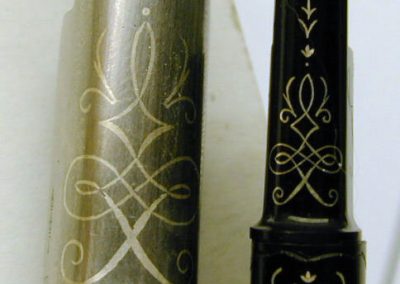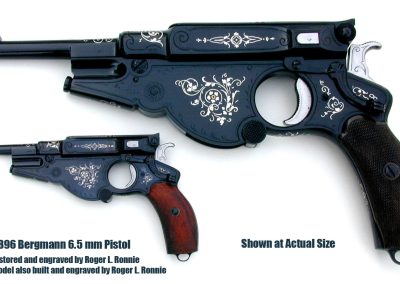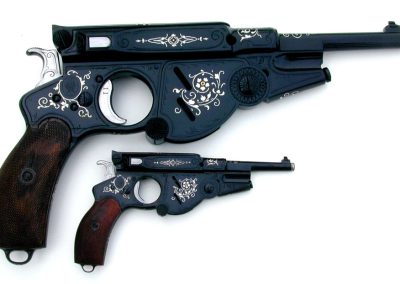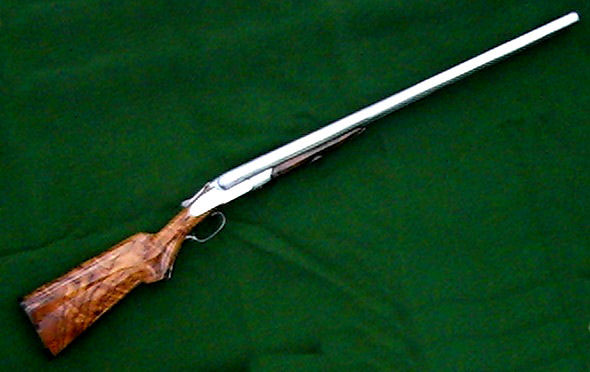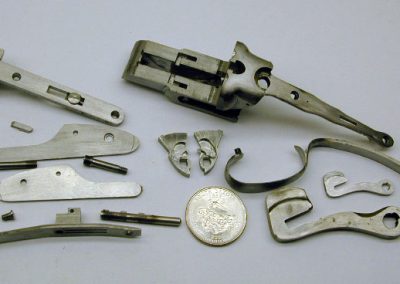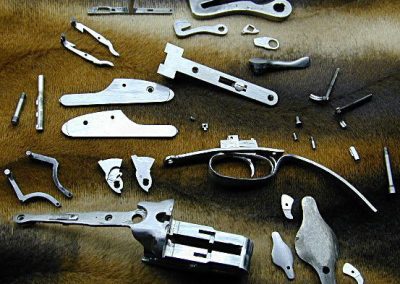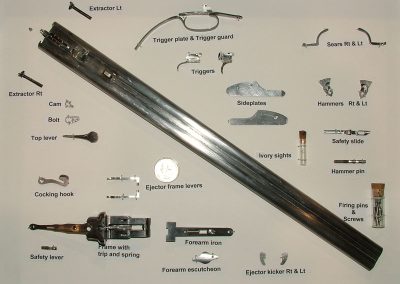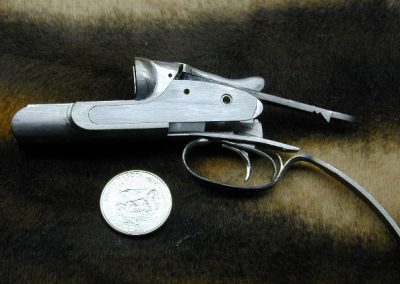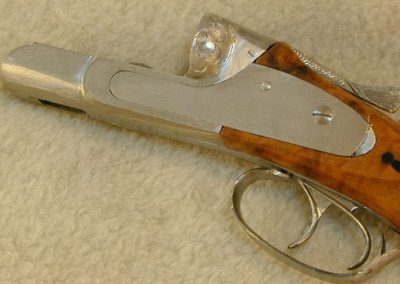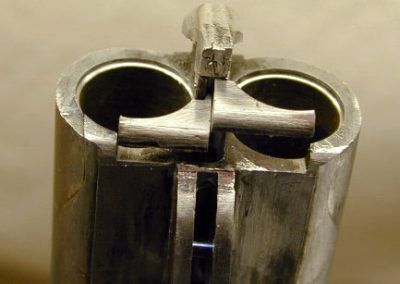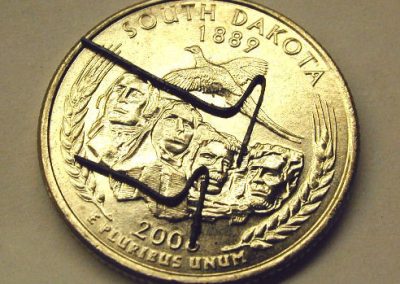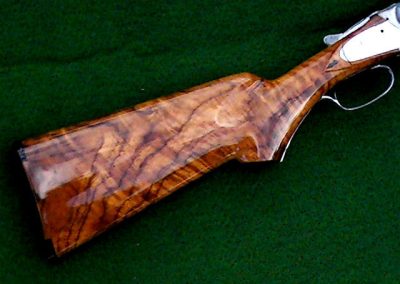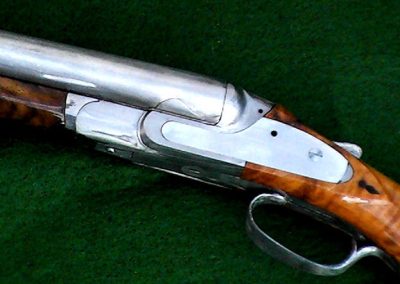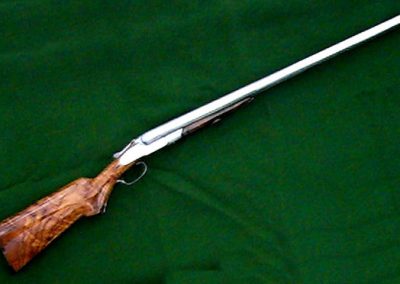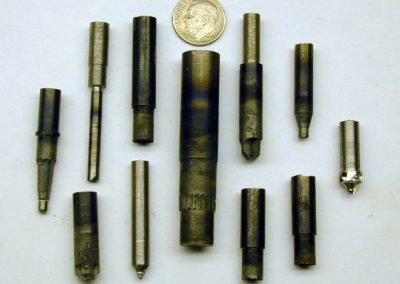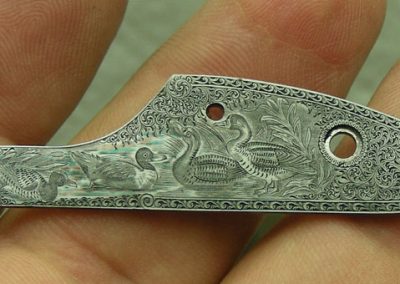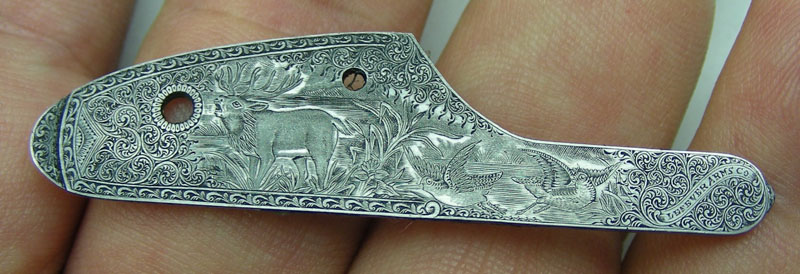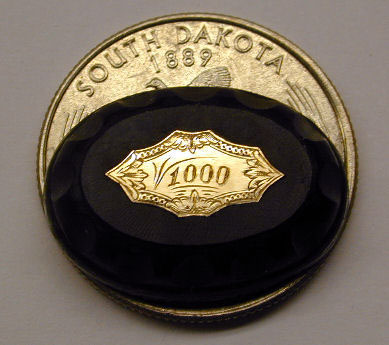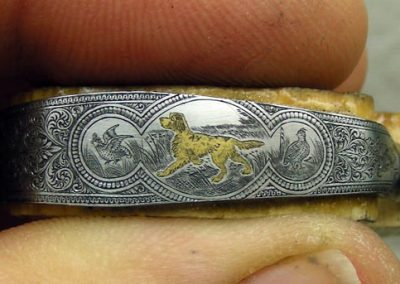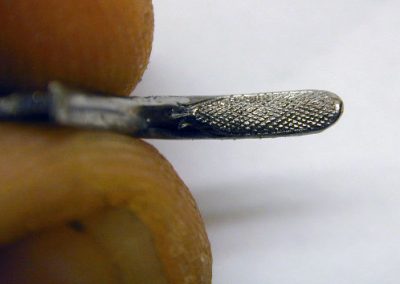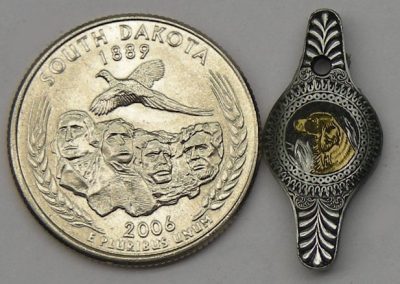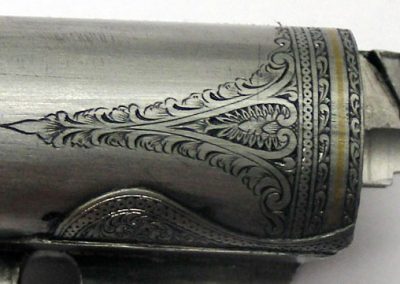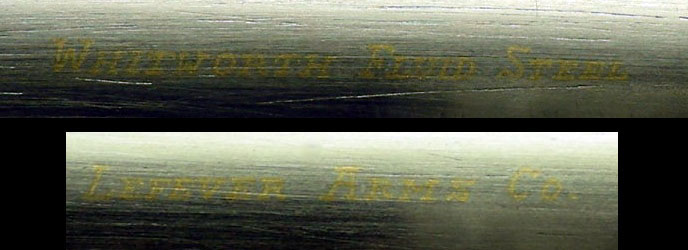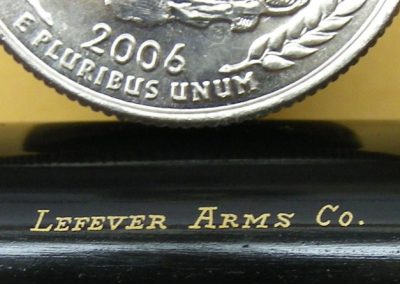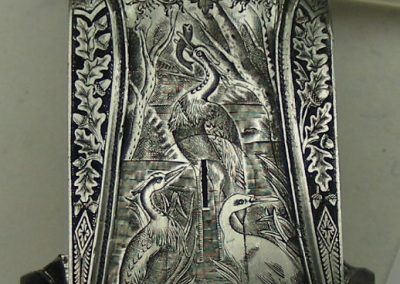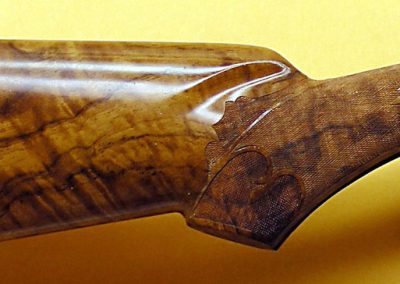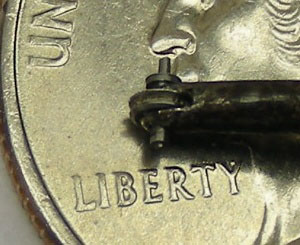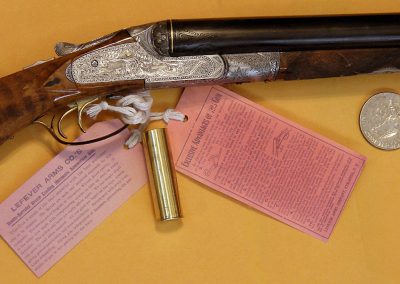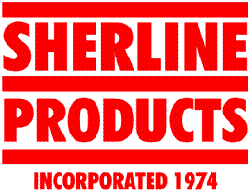Along with his engraving work on firearms, Roger has also built two fully functional miniature guns himself. As a trained gunsmith, Roger has worked on both full-size and miniature firearms, doing both restoration work and full builds.
1/2 Scale 1896 Bergmann Pistol
After working primarily as an engraver for over 30 years, as well as decorating and restoring the finish on many fine guns, Roger decided to use his gunsmith training to full advantage. He decided to take on the project of making a gun of his own entirely from scratch. The photos below detail the construction of a 1/2 scale miniature version of a rare 1896 Bergmann 6.5 mm pistol.
It started when Roger got the opportunity to restore the full-size version of this unique weapon to it’s original condition. Corrosion had eaten into much of the metalwork, almost completely erasing the fine engraving and silver inlay work on parts of the presentation gun. Restoration involved filing down the corroded parts and re-scribing the engraving as he went, until all the surfaces were smooth again.
Once the surfaces were smooth, the original engravings and silver inlaid patterns were restored. Because of its special purpose as a presentation gun made for an honored individual, rather than for normal firing, it has been engraved and inlaid in places not normally decorated. This made the process even more difficult. The undercutting needed for the silver inlay process is difficult enough on a full-size gun, but the model duplicates the same patterns engraved at half-size. The full-size and matching miniature engraved pistols certainly make an interesting pair. Photos below follow the construction process for this miniature.
Additionally, an article in the Miniature Arms Newsletter from April, 2007 features Roger’s miniature Bergmann pistol.
The finished pair of pistols as of October, 2006. The full-size pistol is believed to be either one of the very early prototypes, or a very special model for presentation, due to its low serial number and ornate decoration. Roger said that the full-size model was more difficult to engrave because the gun was in such bad shape at the start. Years of storage in a damp environment had caused a lot of rust. Much of the pistol’s surface had to be filed down below the rust, and then re-engraved. At least when working on the miniature, Roger could engrave on new, flat metal. The enlarged version of this photo, when printed out, shows the two pistols at actual size. To check, a sample measurement of the full-size pistol is 8.5” from the tip of the barrel to the back of the rear sight.
All engraved designs shown are copyrighted by Roger Ronnie and may not be copied or reproduced in any form without written permission.
Full-Size and 1/2 Scale Bergmann Pistols
Roger was given the task of restoring and re-engraving a very rare 1896 6.5 mm Bergmann presentation pistol, which was owned by a famous author. While he had the opportunity, he took dimensions and produced a 1/2 scale, 3.25 mm version of the pistol. Roger hoped to have the model completed, engraved, and silver inlaid by the April, 2007 NAMES show.
Full-Size and 1/2 Scale Bergmann Pistols
This photo shows the disassembled pistol and the model in an earlier stage of construction. A US quarter is used for size reference. The miniature is approximately 15/16″ or 2.4 mm in diameter.
Disassembled 1/2 Scale Bergmann Pistol
Only the miniature Bergmann is shown here, disassembled to its component parts. Included are the wooden grips, and a US quarter for scale reference.
1/2 Scale Pistol Grip
This close-up reveals tiny checkering on the miniature Bergmann pistol grip. The original was done at 30 lines per inch, so the 1/2 scale miniature is 60 lines per inch. Roger cut the grooves with a triangular file completely by hand. Though it looks big here, note from the photo above that the entire width of the grip is less than the diameter of a US quarter!
1/2 Scale Bergmann Pistol
Although this photo appears to show two pistols, they are the same miniature Bergmann seen from both sides, and edited together. Here the miniature pistol is coming along, with grips in place.
1/2 Scale Bergmann Pistol
Closer photos of the right and left sides of the miniature pistol show greater detail. Once the engraving and silver inlay work on the full-size gun is completed, Roger will come back and complete the same work at 1/2 size on the model.
1/2 Scale Bergmann Pistol
The serial number of the model will be the same as the original, except for the addition of “1/2” at the end.
Sulfur Casting
This image shows a sulfur casting taken from the chamber for inspection purposes. Roger noted that this gun was his first project made entirely with miniature machine tools—except for the rifling and checkering of the grip which was done by hand. Even the two special end mills and the chamber reaming tool were made using Sherline tabletop machine tools.
1/2 Scale Bergmann Pistol
The miniature pistol has also been blued, which really makes the silver inlay work stand out in high contrast.
1/2 Scale Bergmann Pistol
This photo shows the finished miniature in several composite views. There are inlays on areas that can’t be seen from side views alone.
Full-Size and 1/2 Scale Pistols
This photo shows a comparison between the barrels of the full-size original still being restored, and the completed miniature.
Bergmann Pistol Pair
Both of these pistols offered unique challenges that tested Roger’s skills in many areas. The results, however, are nothing short of spectacular. Not only was a unique historic firearm restored, but it was also duplicated at 1/2 scale, making a pair that is more valuable together than as individual pieces.
Bergmann Pistol Pair
There are not many craftsman around who have mastered all of the disciplines needed to build and decorate these beautiful pieces.
Bergmann Pistol Pair
Another shot of the finished pistols. New grips were carved from ironwood for the full-size gun, and checkered to match the original.
Roger Ronnie’s miniature gun projects validated Joe Martin’s original intention when he started producing the Sherline miniature lathes and mills. It was his intention to produce relatively inexpensive, small machine tools that would be capable of producing complicated precision projects on a kitchen table—or in a small home shop. Roger’s projects shows that if you have the skill and determination, you don’t need to make a huge investment in tools.
1/2 Scale 1910 Lefever “Thousand Dollar Grade” 10-Gauge Shotgun
For this project, Roger reproduced a 1/2 scale 1910 Lefever shotgun based on photos of an extremely rare original. This unique model is a Lefever “Thousand Dollar Grade” 10-gauge double-barreled shotgun. It was intricately engraved by one of the best gun engravers of the era.
Not knowing exactly what he was looking at when he first took the photos, Roger was able to get detailed shots of the rare gun many years ago. He was mainly documenting the masterful engraving work. After successfully reproducing the Bergmann pistol, Roger decided to take on this project next. Working entirely from his scaled photos of the original shotgun, he was able to reproduce a perfect working model.
Then, the hard part began—replicating the original engravings at half-size. Initially, Roger had considered making the gun at 1/3 scale. He noted that making the shotgun at that size would have been slightly more difficult, but possible. The engraving, however, is so detailed that reproducing it at half-size has been the most difficult task Roger has ever attempted.
Ultimately, he’s glad that he chose 1/2 scale instead of 1/3, as some of the details are barely visible. At 1/3, much of the engraving would have been physically impossible to replicate. Even if it were possible, it wouldn’t be visible without magnification and perfect lighting.
About the “Thousand Dollar Grade” designation: The “$1000 grade” was what Lefever called their top-of-the-line gun, and it was by far the most expensive American shotgun you could buy in 1910. Their “Optimus” grade listed for $400.00, which was still a princely sum, and Parker’s best shotgun, the “Invincible” sold for $750.00. (Keep in mind that in 1910 the average wage was less than $0.20/hour, or about $400.00 a year.)
Some of the Lefever shotguns were known to have barrels made from high quality Damascus steel, which was quite beautiful. However, because each one was essentially made piece by piece to the customer’s specifications, any guns that were purchased for actual use were often made with stronger Whitworth fluid steel barrels.
Only a few of the Lefever $1000 grade guns are known to exist, and collectors must watch out for fakes. Fancy engraving on one of their more common guns could fool the less knowledgeable collector into thinking it is one of the rare models. Roger’s model is probably as close as many people will ever come to being able to appreciate the beauty of this rare gun in person. Reproducing the gun in miniature added another level of difficulty to the project. Roger’s craftsmanship is a fitting tribute to one of the best of the best, and rarest of rare in the world of guns.
More detailed photos from the 1/2 scale Lefever Shotgun project can be seen below. Additionally, an article in the Miniature Arms Newsletter from April, 2008 features Roger’s miniature Lefever shotgun.
Lefever Shotgun Receiver Parts
The original shotgun is so rare that it isn’t shown in most books on Lefever Arms. However, Roger was able to find enough photos of this special 10-gauge double-barreled shotgun to be able to recreate the parts at 1/2 scale. Shown here are parts from the receiver.
Lefever Shotgun Display
This was a display of the shotgun components that Roger made for the 2007 NAMES Expo. It includes the completed barrel assembly.
Lefever Shotgun Detail
This photo shows the receiver and trigger mechanisms installed on the carved wood stock. To get the proper grain, Roger purchased a high-quality full-size gun stock blank, which he selected for its fine grain pattern. He then cut it down to make the half-size version.
Lefever Shotgun Pins and Triggers
Although the mechanism of a double-barreled shotgun may seem simple, there are actually many pins, springs, and parts.
Lefever Shotgun Pins
Making these parts function properly at half-size requires considerably more patience and skill than it would for the full-size firearm.
Lefever Shotgun
It’s hard to tell from these photos that you are not looking at a full-size gun. It took between 1,200-1,300 hours to make the gun, and it would take longer to do the engraving. The last step is bluing the parts and reassembling the gun.
1/2 Scale 1910 Lefever Shotgun
A lined presentation case, reproduction all-brass shotgun shells (as were used in that era), and some scaled down tools would also be made to finish the presentation.
Special Cutting Tools
Like Roger’s miniature Bergmann pistol, the Lefever shotgun was made entirely with Sherline miniature machine tools—with the exception of the barrels, which were too long. Shown here is a selection of special cutting tools that Roger made—also using Sherline tools—for unique operations on the Bergmann and Lefever projects.
Engraving the Miniature Lefever Shotgun
The following photos detail the engraving process for the 1/2 scale Lefever in greater depth. Some images are repeated from Roger’s engraving page, but the rest of the finishing touches for this remarkable scale firearm are also included below.
Lefever Shotgun Side Plate
A side plates for the shotgun. While this plate covers less than one square inch in area, it’s richly engraved with ducks and scrollwork. The words, “Lefever Arms Co.” on the left are a mere 0.0145” high.
Lefever Shotgun Side Plate
The other side plate, featuring more incredible engraving of an elk and birds.
Lefever Shotgun Ornament
This photo shows the special engraved gold ornament that goes on the shotgun grip cap, sitting on top of a US quarter for scale reference. The ornament identifies the gun as being the rare Thousand Dollar Grade model. Roger had to grind special gravers to do some of this extremely small work.
Lefever Shotgun Tang
Extremely fine engraving on the top tang is put into scale when placed next to a US dime.
Lefever Shotgun Trigger Guard
The unfinished trigger guard, with birds and an inlaid gold hunting dog.
Lefever Shotgun Forearm Button
The tiny forearm button is engraved with the gold inlaid figure of a hunting dog, enclosed in an intricate border. A US quarter lends a sense of scale.
Lefever Shotgun Receiver
A close-up of the “doll’s head” near the receiver end of the barrel. The top portion of a US quarter shows the tiny scale.
Lefever Shotgun Inlay
This fine gold inlaid lettering is only .024” high. Against the bare metal it’s difficult to see, but after the barrel was blued the lettering came out in sharper contrast. However, Roger faced a dilemma in that bluing the barrel to highlight the gold inlays could make the rest of the engraving details more difficult to see.
Lefever Shotgun Inlay
In January, 2008 Roger decided to blue the barrel. This photo shows why. Note how much better the fine inlaid gold lettering shows up here compared to the previous photo.
Lefever Shotgun Receiver
The bottom of the receiver incorporates a very detailed hunting scene with birds and foliage. Also, note the extremely close fit of the parts.
Lefever Shotgun Stock
Creating perfectly regular patterns with straight lines is extremely difficult. Complicated curved patterns are impressive, but slight variations or irregularities are hard to pick up. On the other hand, any variations in width or spacing on a series of parallel straight lines is easily picked up by the human eye.
Lefever Shotgun Stock
The checkering on the stock was completed in December, 2007. At 1/2 scale, the distance between the lines is a mere .016” (64 lines per inch) in some areas, and 0.0125” (80 lines per inch) in the finer areas.
Custom Checkering Tool
Once a line was scribed, Roger used this tiny handmade tool to follow the first line and mark the next one. Once scribed, the lines were made using a small triangular file which leaves tiny diamond shapes between the angled lines. Keeping depth consistent over the curved surfaces requires extreme control and a lot of patience.
Lefever Shotgun Forearm Plate
An engraved and inlaid metal plate is inset on the forearm plate. The center area of the plate was checkered at 64 lines per inch. The outer ends of the plate, between the “ribbons,” were checkered at 80 lines per inch.
1/2 Scale 1910 Lefever Thousand Dollar Grade Shotgun
A close-up of the finished, engraved, and blued miniature shotgun. The finished piece also includes scale reproductions of the original tags, and a 10-gauge all-brass shotgun shell.
1/2 Scale 1910 Lefever Thousand Dollar Grade Shotgun
A top view reveals the small gold inlaid lettering.
Return to Roger Ronnie’s main page.
This section is sponsored by:
Makers of precision miniature machine tools and accessories. Sherline tools are made in the USA.
Sherline is proud to confirm that Roger Ronnie uses Sherline tools in the production of some of his small projects.

